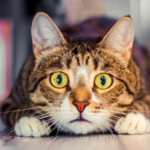Lilies are some of the most vibrant and beautiful flowers available to decorate your home and gardens with, however for those who have feline members of the family, you may want to reconsider. There are many different species of lilies such as the Easter lily, day lily, Asiatic lily, tiger lily, peace lily, calla lily, and lily of the valley and so many more. If your cat was to ingest any part of these plants, it could result in fatal consequences. Cats that consume as little as two leaves of a lily plant are exposed to the chance of fatal kidney failure. Immediate intervention by your veterinarian is recommended to ensure that your kitty cat has the best chance of surviving a lily toxicity. In cases that are left untreated cats have been shown to succumb to the toxicity in as little as three days.
The lily plants of greatest concern are any from the genus Lilium (Lilium sp.), which includes Easter lilies, tiger lilies and Asiatic lilies, as well as any from the genus Hemerocallis (Hemerocallis sp.), which includes day lilies.
WHAT TO WATCH FOR
- Drooling
- Loss of appetite
- Dehydration
- Vomiting (with pieces of plant material present)
VETERINARY CARE
If you have seen your cat ingest part of the lily or feel that it may have only happened recently and you don’t think that your cat has vomited on their own, your vet may try to induce vomiting. This helps to remove the plant material from the system before full absorption can take place. Your cat will then spend some time at the vet in hospital on supportive intravenous fluids to prevent dehydration and the shutdown of their kidneys.
If possible, we recommend not having lilies in your house, not even as cut flowers. However, if you do have lilies in the house, ensure that your cat cannot reach them and inform everyone in your household of the danger’s lilies pose to your feline friend.






